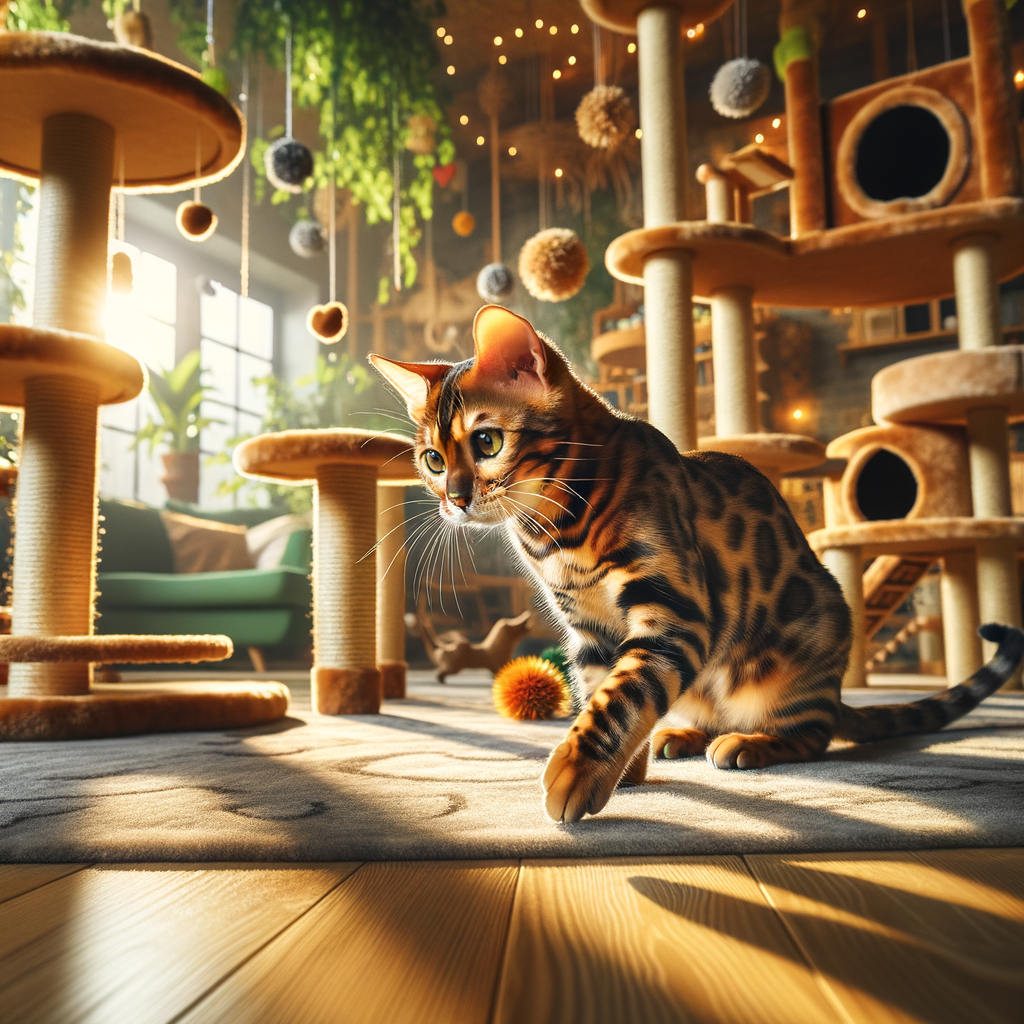
Introduction: The Impact of Environment on Bengal Cat Behavior
Bengal cats are known for their playful and energetic nature. They are unique and have specific needs. Understanding their behavior and the role of their environment is key to ensuring they are happy and healthy.
-
Understanding Bengal cat behavior:
They love to explore and play. They can be very affectionate but also need their space. Knowing these traits helps in creating a suitable environment for them.
-
Importance of environment in shaping Bengal cat personality:
A stimulating environment with plenty of toys and space to roam can make a Bengal cat more confident and happy. On the other hand, a boring or stressful environment can lead to behavioral problems.
In this blog post, we will explore how different environments affect Bengal cats. We will also provide tips on creating the best environment for your Bengal cat. Stay tuned to learn more!
Bengal Cat Behavior: An Overview
Bengal cats are known for their unique and lively behavior. Understanding their temperament and behavior changes can help you provide a better environment for them.
-
Typical Bengal cat temperament:
They love to climb, jump, and explore. These cats are also very curious and intelligent. They enjoy interactive toys and puzzles. Bengals are often described as dog-like because they can be trained to fetch and walk on a leash.
-
Common Bengal cat behavior changes:
Bengal cats may show changes in behavior due to various factors. For example, they might become more vocal or less active if they are bored or stressed. Changes in their environment, such as moving to a new home or introducing a new pet, can also affect their behavior. Monitor these changes and consult a vet if needed.
| Behavior | Description |
|---|---|
| Playfulness | Bengals are very playful and need lots of stimulation. |
| Curiosity | They love to explore and investigate their surroundings. |
| Vocalization | Bengals can be quite vocal, especially when they want attention. |
| Adaptability | They may take time to adjust to new environments or changes. |
Environmental Factors Influencing Bengal Cats
Physical Environment
- The role of Bengal cat habitat in their behavior
Their habitat plays a crucial role in shaping these behaviors. A stimulating environment with plenty of space to explore can help keep them active and happy. According to a study by the Animal Behavior Society, cats that have access to diverse environments exhibit more positive behaviors.
- How living conditions can affect Bengal cats
Poor living conditions, such as cramped spaces or lack of stimulation, can lead to stress and behavioral issues. On the other hand, a clean, spacious, and engaging environment can promote good health and positive behavior. For example, providing climbing structures and interactive toys can help meet their physical and mental needs.
| Factor | Impact on Behavior |
|---|---|
| Space | More space allows for more exploration and play, reducing stress. |
| Stimulation | Interactive toys and climbing structures keep Bengal cats engaged and happy. |
| Cleanliness | A clean environment prevents health issues and promotes positive behavior. |
Social Environment
-
The Impact of Human Interaction on Bengal Cat Behavior
Human interaction plays a big role in shaping their behavior. When Bengal cats receive regular attention and playtime, they tend to be more social and well-behaved.
For example, spending at least 30 minutes a day playing with your Bengal cat can help reduce unwanted behaviors like scratching furniture. According to a study, cats that engage with their owners are 50% less likely to develop behavioral issues (source).
-
How Other Pets Can Influence Bengal Cat Temperament
If introduced properly, Bengal cats can get along well with dogs and other cats. However, the introduction process is crucial.
For instance, a gradual introduction over a week can help Bengal cats feel more comfortable. A study found that 70% of Bengal cats showed positive behavior changes when introduced slowly to new pets (source).
Factor Impact on Bengal Cats Human Interaction Increases social behavior and reduces unwanted actions Other Pets Can improve temperament if introduced properly
Best Environment for Bengal Cats
Indoor vs Outdoor
-
Pros and Cons of Indoor Living for Bengal Cats
Indoor living can be very safe for Bengal cats. Here are some pros and cons:
Pros Cons Safe from traffic and predators Can get bored easily Less risk of diseases May become overweight Controlled environment Needs more mental stimulation Indoor cats are safe from cars and other animals. They also have a lower risk of catching diseases. However, they can get bored and may gain weight if not active. Provide toys and activities to keep them happy.
-
Pros and Cons of Outdoor Living for Bengal Cats
Outdoor living can be exciting but risky for Bengal cats. Here are some pros and cons:
Pros Cons Lots of space to explore Risk of getting lost Natural exercise Danger from traffic More mental stimulation Exposure to diseases Outdoor cats have more space to explore and get natural exercise. They also get more mental stimulation from their surroundings. However, they risk getting lost, hit by cars, or catching diseases. Always weigh these factors before letting your Bengal cat outside.
Creating a Stimulating Environment
-
Importance of Play and Mental Stimulation for Bengal Cats
They need regular play and mental challenges to stay happy and healthy. Without enough stimulation, they can become bored and may develop behavioral problems.
Play helps Bengal cats exercise their bodies and minds. It keeps their muscles strong and their minds sharp.
According to a study, cats that engage in regular play are less likely to show signs of depression and anxiety. This is especially true for Bengal cats, who are naturally curious and active.
-
Recommended Toys and Activities for Bengal Cats
- Interactive Toys: Toys that move or make noise can capture your cat’s attention. Examples include laser pointers, feather wands, and electronic mice.
- Puzzle Feeders: These toys make your cat work for their food. They can help stimulate your cat’s mind and slow down their eating.
- Climbing Structures: Bengal cats love to climb. Cat trees and shelves can give them a place to explore and exercise.
- Fetch Games: Some Bengal cats enjoy playing fetch. You can use small balls or soft toys for this activity.
- Water Play: Many Bengal cats are fascinated by water. You can provide a shallow dish of water for them to splash in.
In addition to toys, you can also engage your Bengal cat in activities like training sessions and outdoor walks on a leash. These activities can provide both physical and mental stimulation.
Activity Benefits Interactive Toys Engages attention, provides exercise Puzzle Feeders Stimulates mind, slows eating Climbing Structures Encourages climbing, provides exercise Fetch Games Provides exercise, strengthens bond Water Play Stimulates curiosity, provides entertainment
Case Studies: How Environment Affects Bengal Cats
-
Case Study 1: Bengal Cat Behavior Changes Due to Relocation
Meet Luna, a 3-year-old Bengal cat. Luna lived in a quiet suburban home with her owner. She was playful and loved exploring her backyard. However, when her owner moved to a busy city apartment, Luna’s behavior changed.
In the new environment, Luna became more anxious. She started hiding under furniture and was less playful. The noise and lack of outdoor space seemed to stress her out.
Key Insight: Bengal cats may become anxious and less active when moved to a noisier and smaller environment.
-
Case Study 2: Bengal Cat Temperament Alteration Due to New Pet Introduction
Max, a 2-year-old Bengal cat, was the only pet in his household. He was friendly and loved attention. One day, his owners brought home a new puppy.
At first, Max was curious about the puppy. But soon, he became more aggressive and territorial. He started hissing and swatting at the puppy. His owners noticed that Max was also eating less and seemed stressed.
Key Insight: Introducing a new pet can make a Bengal cat feel threatened and change its behavior.
Key Takeaways: Bengal Cat Environment and Behavior
-
The crucial role of environment in shaping Bengal cat behavior:
A calm and safe place helps them feel happy and behave well. If their space is noisy or stressful, they might act out or feel scared.
-
How to create the best environment for Bengal cats:
To make a Bengal cat feel at home, give them plenty of space to play and climb. Use cat trees, scratching posts, and toys. Make sure they have a quiet place to rest. Keep their litter box clean and provide fresh water and food.
-
Understanding and managing Bengal cat behavior changes:
This can happen if they are bored, sick, or stressed. Watch for signs like hiding, not eating, or being too active. If you notice changes, try to find out what’s wrong and fix it. Sometimes, a vet visit might be needed.
| Key Insight | Details |
|---|---|
| Environment’s Impact | A calm, safe environment leads to happy and well-behaved Bengal cats. |
| Creating the Best Space | Provide space to play, climb, and rest. Use toys, cat trees, and keep the area clean. |
| Behavior Changes | Watch for changes in behavior. Address issues like boredom or stress quickly. |






